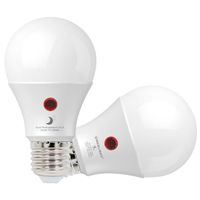E27/B22 LED Sensor Lamp Dusk to Dawn Night Light Dual Photosensors
- $1.80 / >=1000 pieces
- 1000 pieces
- Xiamen Yooland Optoelectronics Co., Ltd.
- Fujian, China
- Mr
Product Detail
| FOB port: | Xiamen | Packaging Details: | SINCELIGHT standard package or OEM package |
| Lamp luminous flux (lm): | 850-900 lumens | power supply: | air conditioner |
| Lamp Luminous Efficiency (lm/w): | 100 | port: | Xiamen |
| type: | sensor bulb | Beam angle: | 220 degrees |
| brand: | Si Guang | Lifespan (hours): | 20000 |
| Origin: | Fujian China | Sensing range: | Infrared 850-1100nm |
| Input voltage (V): | 200-220V | model: | A60 |
| Color rendering index (Ra>): | 85 | Color temperature (CCT): | 3000K/4000K/6000K |
| Warranty (year): | 3 years | light source: | to lead |
| switch mode: | Auto On/Off, Daylight Sensor | Bulb Type: | A60 B22/E27 |
| payment terms: | L/C, Western Union, T/T | Function: | dusk to dawn |
| Supply capacity: | 1,000,000 pieces per month | Lighting Solutions Services: | Lighting and Circuit Design |
Dual photoelectric sensor V 2.0
| dusk to dawn |



data sheet
| Excellent value for money |
|electrical date| | ||||||||
Voltage (V) | 200-240Vac/60Hz | |||||||
Power factor ( λ ) | 0.5+ | |||||||
start time (seconds) | <0.5 | |||||||
Warm up time (seconds) | instant full light | |||||||
|product date| | ||||||||
bulb type | A19 Dusk to Dawn Bulb | |||||||
lamp holder | E27/B22 | |||||||
Beam angle | 220° | |||||||
Product power ( W ) | 9W | |||||||
Equivalent wattage ( W ) | 85-90W | |||||||
Color temperature (K) | 3000K / 4000K / 6000K | |||||||
Color Rendering Index ( Ra ) | 85° | |||||||
energy label | a + | |||||||
Operating temperature | -30°C to +40°C | |||||||
Switching cycle (times) | >2,000,000 | |||||||
Mercury content (mg) | not applicable | |||||||
Weight / grams) | 65 grams | |||||||
|performance date| | ||||||||
Total luminous flux (lm) | 850-900 lumens | |||||||
Rated life (hours) | 15,000 hours | |||||||
|aspect| | ||||||||
Diameter (mm) | 60mm | |||||||
Length (mm) | 110mm | |||||||
Project cases


color performance
Color temperature optional
| 3000K, 4000K, 6000K |
high color rendering index
RA≈85




color temperature
The color temperature of a light source is taken from the temperature of a perfect black body radiator that radiates light with an appearance similar to that of the light source. It is measured in absolute temperature units; Kelvin (K). Interestingly,
Although red is associated with warm colors and blue is associated with cool colors, blue appears higher on the black body curve
The temperature is higher than red. A more visual example of this apparent color temperature contradiction can be seen in candlelight, which emits a warm reddish-orange light but is actually cooler in Kelvin at 1850K. Therefore, higher color temperatures (above 5000K) are called cool colors (blue-white); lower color temperatures (2700 – 3000K) are called warm colors (yellow-white to red).
Although red is associated with warm colors and blue is associated with cool colors, blue appears higher on the black body curve
The temperature is higher than red. A more visual example of this apparent color temperature contradiction can be seen in candlelight, which emits a warm reddish-orange light but is actually cooler in Kelvin at 1850K. Therefore, higher color temperatures (above 5000K) are called cool colors (blue-white); lower color temperatures (2700 – 3000K) are called warm colors (yellow-white to red).
Color rendering index
(Radio International)
The Color Rendering Index (CRI or Ra) is a quantitative measure used to evaluate the ability of a light source to faithfully reproduce the color of an object. To objectively compare the color rendering characteristics of any light source, the CIE's standardized measurement uses a scale of 0 to 100 (poor to excellent). Calculates the color change of 14 standard colors when an object is exposed to a specific light source and then compares it to a reference light source of the same color temperature (black bodies* for color temperatures up to 5000K and daylight above 5000K). CRI for a pair of light sources Comparisons can only be made with the same color temperature. The CRI scale is chosen so that, by definition, an ideal blackbody light source such as an incandescent or halogen lamp has a CRI rating of 100. For light sources that emit a discrete spectrum, such as LEDs and discharge lamps, the CRI can be anywhere between 0 - 100. As a rule of thumb, the more the spectrum is filled in all wavelengths (380–760nm), the better the color rendering of the light source Well, but a high CRI measurement essentially means less efficiency (since less efficient wavelengths are also represented in the spectrum). * A black body is a theoretical object that absorbs all incident electromagnetic radiation and, due to its ability to absorb all wavelengths, is the best possible emitter of thermal radiation. It radiates a continuous spectrum that depends on the temperature of the body.
color consistency
( SDCM )
| SiguangSDCM<5|
The key to creating an LED lighting scheme that looks good for years to come is ensuring that all lamps perform within acceptable tolerances for color shift over their lifetime. To define "acceptable tolerance" from lamp to lamp, LED manufacturers use the MacAdam ellipse and SDCM (Standard Deviation of Color Matching) to measure color consistency.
McAdam Ellipse
The MacAdam ellipse is a color measurement system. It measures how much color variation is possible around these axes, then
The human eye detects the color change. A series of ellipses can then be drawn around any target color, the closer any given light is to the target, the less color deviation there will be when those lights are placed side by side in an installation.
SINCELIGHT® Performance
SINCELIGHT® LED professional light sources have a color consistency of 3-5 SDCM due to SINCELIGHT®'s control over phosphor/LED mixing.
McAdam Ellipse
The MacAdam ellipse is a color measurement system. It measures how much color variation is possible around these axes, then
The human eye detects the color change. A series of ellipses can then be drawn around any target color, the closer any given light is to the target, the less color deviation there will be when those lights are placed side by side in an installation.
The distance from the target point in each ellipse is measured in SDCM. SDCM of order 1 means no color difference between LED chips, 2-3 SDCM means hardly any visible color difference. The color consistency of 6-7 SDCM is accepted by the market and complies with European Ecodesign-US Energy Star requirements.
SINCELIGHT® Performance
SINCELIGHT® LED professional light sources have a color consistency of 3-5 SDCM due to SINCELIGHT®'s control over phosphor/LED mixing.
VIEW MORE
Related Products
-
Flood Light 1900lm Motion Sensor 2 LED Head Outdoor Security 20W
Number of lights: 2 strength: 20W Protection level: IP65 Single piece packaging size: 26X20X19cm Power factor: >0.9 Switch mode: sensor Material: Aluminum+PC brand: JJC color: black, white, brown Warranty period (years): 5 years Gross weight of single piece: 3.000kg application: outdoor Input...... -
Solar Outdoor Wall Light Waterproof Motion Sensor Warning Light Security Light with Sound Alarm
Package preview: Gross weight of single piece: 0.600kg Solar panels: polysilicon Battery: 3.7V 1500mAh Working hours (hours): 10000 Lamp body material: personal computer Lamp luminous flux (lm): 300-450 Protection level: IP65-waterproof product name: Solar garden light brand: Shanda Lighting Sales..... -
Factory Supply Outdoor Garden Controlled LED Security Light Using Triple Head Motion Sensor
Lighting Solutions Services: Lighting and Circuit Design Material: Metal application: outdoor Protection class: IP54 power supply: electrical product name: LED security light color: White Warranty period (years): other Class I: IP54 and wet locations Shell color: black/white/bronze Working hours...... -
E27 Dusk to Dawn LED Daylight Sensor Bulb with Dual Photo Sensor Auto On/Off Night Light Security Light
Lifespan (hours): 20000 Base Type: B22/E27/E26 Supported dimmers: No Sensing range: Infrared 850-1100nm Input voltage (V): AC 110V (±10%), AC 220V (±10%) payment terms: L/C, Western Union, T/T Product weight (kg): 0.2 Function: dusk to dawn sensor Beam Angle: 220 degrees Beam Angle(°): 220 Warranty.... -
Solar Night Light Alarm Motion Sensor Outdoor Detector Lamps 129db Waterproof Sound Warning for Farm Yard Fence
Working hours (hours): 50000 Supported dimmers: No Beam Angle(°): 120 Solar panels: 5V/120ma polysilicon Product weight (kg): 0.2 Supply capacity: 50000 pieces per month Operating mode: 4 modes payment terms: L/C, Western Union, T/T, PayPal brand: Processing Lifespan (hours): 50000 Lighting...... -
2022 New Solar Powered LED Emergency Light Bulb Outdoor Indoor Home Light with Solar Panel
Product weight (kg): 0.5 battery capacity: 900mAh Solar panels: 6V1W Lifespan (hours): 50000 Lighting Solutions Services: Lighting and Circuit Design Beam Angle(°): 270 Base Type: E27 Product Size: 82*82*137mm light source: to lead Working hours (hours): 50000 Number of lamps: 1 Single pack size:...... -
Outdoor Solar Stake Light, Garden Villa Yard LED Light Butterfly Stake Color Changing Decoration led solar garden light/
Solar panels: 1.2V 600mAh Solar LED Flood Light: 50w 100w 200w 300w light source: light emitting diode usage: street garden square highway Lamp Luminous Efficiency (lm/w): 80 Supply capacity: 1,000,000 pieces per month application: patio switch mode: wifi, sensor, manual button, bluetooth, remote...... -
800 Lumens 8 LED IP66 Waterproof Wireless Solar Floodlight Spotlight 5W Solar Outdoor
Beam Angle(°): 270 Number of lights: 8 lights Protection class: IP65 application: outdoor light source: light emitting diode power supply: Battery Supported dimmers: Yes Origin: China Packaging Details: China Manufacturer OEM/ODM Wholesale 6" Mini Cooler Fan 1. PE Bag, 2.. Color Box + Manual...... -
77 LED Solar Light Motion Sensor Security Virtual Camera Wireless Outdoor Flood Light IP65 Waterproof Light 3 Modes for Home Garden
product material: ABS Lamp luminous flux (lm): 3000 lumens Application 2: security lighting port: Shenzhen payment terms: L/C, Western Union, D/P, D/A, T/T, MoneyGram, Paypal Supported dimmers: Yes Working hours (hours): 50000 application: Home Outdoor Gardening model: SM-SCC-L Application 3:...... -
Outdoor Solar Light, Wireless 30 LED Motion Sensor Solar Light, Large Lighting Area, Easy to Install Waterproof Security Light
waterproof level: IP65 rated power: 0.55W Packaging Details: Color box/white box to carton or customized packing model: Fiscal Year 60 Charging time: 6-8 hours (1000W/cubic meter) Light Type: solar port: Shenzhen, Hong Kong Origin: Guangdong, China Voltage: 3.7V LED color: White 2700~6000K......










